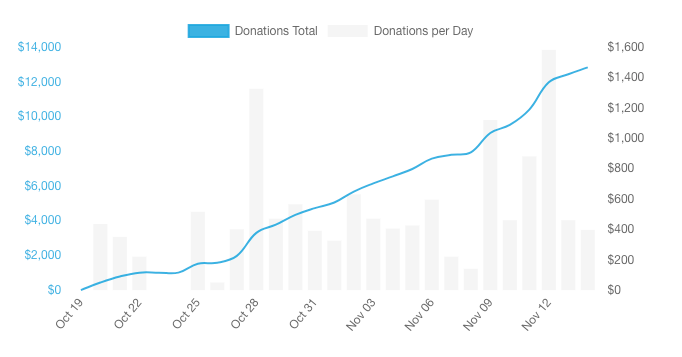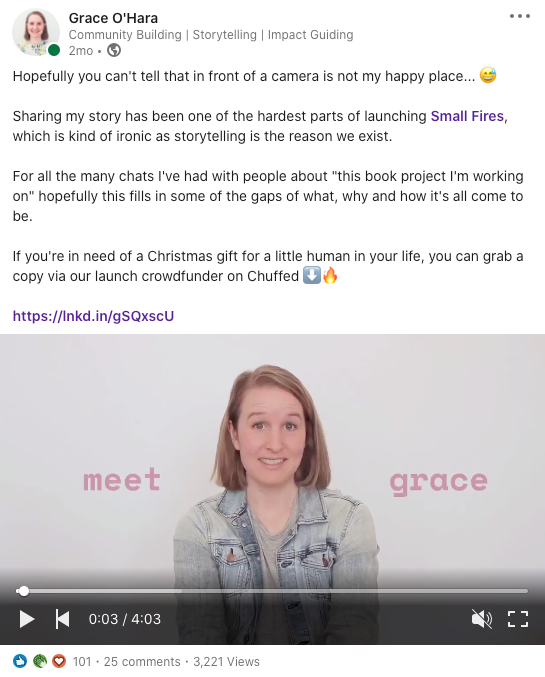In the tail end of 2020, the team managed to do something we’ve been working on for two years: we managed to bring our first book into the world!
It was a whirlwind journey in some ways, and a black hole in others. If you're thinking of pursuing a crowdfunding campaign for your own story, here's what the experience was like for us.
Phase One: This Isn’t Going To Happen
Why we decided to eventually go for crowdfunding
In August, we decided to launch pre-sales for the first book through our website. The hope was that we’d built up enough of a community and knew enough people that we’d be able to pre-sell the required amount to fund our first print run. The number we were aiming for? About 600.
Within two weeks we’d hit 25% of our goal, and then… crickets.
It was painful, it was sleepless, it was overwhelming.
Trying to market a completely new product, that’s a bit different, and didn’t yet physically exist was really hard. Doing it in the middle of a pandemic was impossible for us.
The face to face connections and events usually available to bookmakers (think school tours, book launches and library visits) were completely off the table. And being a tiny team, juggling other things at this point, we had to realise our own limits.

A mockup of the print-ready file used during our launch and crowdfunding campaign.
We’d chosen to not go down the crowdfunding route due to the cut many platforms took, the stress of time-boxing a campaign, and the all or nothing set up that many offer.
We came back to the idea once we realised that urgency, or a deadline, cannot be understated, and that the concept of a crowdfunding campaign was much more familiar (and so might have much more traction) that going it alone.
We also did some more research into crowdfunding platforms and found the good folks at Chuffed, who we ended up working with. Unlike other platforms, they give you a few options about the fees associated with crowdfunding (more on that below). They also had a relatively short turnaround timeframe in getting a project live (which was important as the year was coming to a close), while still offering a tonne of useful advice.
Within two weeks of deciding to try a wild new strategy (crowdfunding) we had our page live and had our first donations in.
Here’s how we did it and what happened next.
Phase Two: How Do We Actually Make This Happen?
How we set up and ran our crowdfunding campaignIf you’re about to embark on a similar journey, here’s where you can get into the nitty gritty.
- We set our goal for $12,000 which wasn’t recommended unless we had a subscriber list of 1000 or more people. We didn’t have that, but we decided our determination would help see us through… brazen, huh?
- We went with a campaign length of 26 days. Mostly because we’d read that the first and last weeks are most crucial, and things kind of float in between (can vouch, this is true). Plus we were working backwards on a strict printing deadline, in order to get the books out by Christmas.
- Thanks to Chuffed we were able to go a split fee system, in which we absorbed the transaction fee of the card payment (about 3%) and then our supporters were able to add an optional contribution to Chuffed.
- We went for a “keep what you raise” model which means, even if you don’t hit your goal, you get to keep the amount you raise. I wouldn’t recommend this for every product based launch, but through our early website sales, we knew we would be able to print a smaller batch (with about 0% profit margin) even if we weren’t able to raised any more. That is to say, we knew we were able to bring the thing to life even if a handful of people contributed.
- One last reason as to why we went with Chuffed: supporters don’t need to register an account before they contribute. This was a massive factor I hadn’t thought about until chatting with some family friends who stressed how important it was to make it as easy as possible. While I can’t say for sure if it made a difference, it was a significant factor in our decision making after that!

Donation data from our campaign showing daily donations and overall total.
While we don’t feel like we’ve unlocked the secret sauce in running successful campaigns, there’s a few things we can share about our journey:
✅ Get your closest family and friends to donate to your page before you launch it (this is possible on many platforms). That way when the first people land on your launched page, they won’t have to take the leap to be the first donors.
✅ Write a whole bunch of email templates, thank you messages and social media posts before you launch. There’ll be 1000 things happening during the campaign, do the work ahead of time and you’ll love yourself for it. We wrote a templated (but personal) email thank you to every person that donated (which got great feedback). We also had emails ready to go to our newsletter base for the launch and final week, along with emails through Chuffed that let people know when you hit certain goals (25% funded etc).
✅ Social media works a treat. We saw a lot of donations come in through our personal LinkedIn and Facebook pages, from our professional friends and old friends and eventually, friends of friends. Keeping it casual, keeping it authentic and tagging people in posts were the best way to see posts go viral. Here’s an example:

✅ While we’re on the topic — about 80% of your supporters will be friends and family. The more you can tell them about this journey, the less of a surprise it’ll be when you launch your page!
✅ Spend the time (or money) in making good quality graphics or a video. Our amazing designer, Tess Copeland, was a whizz at getting thumbnails together for our different perks which helped to differentiate the items and keep it clean. Meanwhile I managed to hack together a video using a single take of me in a living room, mixed in with some stock video and music from Storyblocks (the best and most reasonable stock site I’ve found).
✅ If you have any speaking opportunities upcoming, make sure it happens during your crowdfunding period. If you noticed that the 28th October was an outlier in the donor data above, it’s because it was the day we participated in (and won — yay!) a pitch competition in Australia. Along with the amazing prizes, it gave us an amazing opportunity to share our story and campaign.
✅ Ramp up towards the end. Urgency is relevant everywhere, no matter what industry you’re in. There were people who donated in the last week who’d we’d assumed donated in the first week — awkward! People are busy, people will add it to a to-do list that never gets done. Adding gentle, fun reminders and a countdown to the finish line will give people the time they need to support you!
✅ Advertise wisely. We actually worked on an advertising campaign with the Chuffed team, who ran Facebook ads to people who’d contributed to other campaigns. This was a massive success for us (we think because it was leveraging their brand and audience) and helped to test a bunch of messages, and reach new people quickly. For about $900 of spend, it resulted in almost $3000 of donations! If you want to know more about the nitty gritty on this, reach out, we’re always happy to chat. We also experimented with our own ads on Facebook and got basically zilch. So yes, spend wisely.
❌ Finally, some things that didn’t seem to do a lot. To be fair, it doesn’t hurt to try as much as you can, as long as you’re not putting your eggs all in one basket. Here’s what we found didn’t result in a lot of movement however:
- Posting into Facebook groups, or finding relevant posts to share our campaign on (ie. a lot of Christmas lists were being generated and we put our hand up for quite a few).
- Online PR. We reached out to a bunch of publications about our launch and didn’t get anything back. We had a few small successes with guest posting on sites, but this resulted in very few clicks to our website, compared to the effort it took to pitch and write the piece. These also sometimes took months (yes, months) to be published.
- Influencers. It’s hard to talk about a something that doesn’t exist yet. We tried to get around this by creating a special digital preview for people to get an advanced peek at. A few people were up for sharing our story on Instagram, but to be honest, the least amount of traffic came from there and we’re not sure if any resulted in donations.
So, what happened next?
We ended up hitting our goal three days ahead of our deadline, which meant that we created a few extra incentives to keep the donations coming in (for example, if we hit $13K we’d commit to donating 50 books locally around Melbourne - which we did).
A final piece of advice would be to make sure you have a celebration planned, and if possible, some downtime available after the campaign wraps. It’s an intense experience, full of sleepless nights, worry and stress. In amongst that though are beautiful moments of connection and validation that you’re doing something that people are excited about.
The whiplash between extremes takes its toll — and rest after the wrap wasn’t an option for us (though we desperately needed it).
If you have any questions or want to chat something through, reach out to us here. If you’re on the fence about launching an idea through crowdfunding… give it a go! Anything is possible.
Lessons Learned is a regular series from Small Fires about all the many things we’re learning as we create an organisation and products we’re proud of.
Part reflection, part working in the open, these learnings are here to share what we’re discovering and also give an insight into the operations and thinking behind the organisation. Have a question for us? We'd love to hear from you. Reach out to us here.
📸 Top photo by micheile dot com on Unsplash
